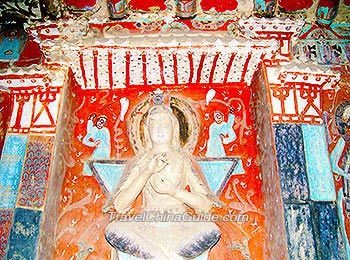Iconada.tv 愛墾 網
文化有根 創意是伴 Bridging Creativity
Culture of Silk Road
The ancient Silk Road contributed greatly to the cultural exchange between China and the West. From the second century BC to the fifteenth century AD, splendid civilizations among China, India, Greece, Persia and Rome were exchanged along this famous trade route, making the route a great "Cultural Bridge" between Asia and Europe.
Religions Introduced into China via Silk Road
Together with the economic and political exchange between the East and West, religions of the West were introduced into China via the world-famous route. Buddhism, Zoroastrianism, Manicheism, Nestorianism and Islam were cultural treasure of the ancient west, which were bestowed upon China during the old times.
 |
| Buddha Statue in Mogao Caves, Dunhuang |
Buddhism
In the first century BC, Buddhism was introduced into Yutian (Now Hetian). From there, it quickly spread throughout the vast Western Regions. It was not until the Eastern Han Dynasty (25-220) that Buddhism infiltrated the inland of China. In the following centuries, many monks played important roles in the development of Buddhism in China. These included monks such as Zhu Shixing in the Three Kingdoms (220-280), Fa Xian and Kumrajva in the Jin Dynasty (265-420), Song Yun and Hui Sheng in the Northern Dynasties (420-589) and Xuan Zang in the Tang Dynasty (618-907). They traveled on the route to ancient India to study sutras, contributed greatly to the propagation of Buddhism.
Zoroastrianism, Manicheism and Nestorianism were called the "Three Foreign Religions" in the Tang Dynasty.
Zoroastrianism
From the fifth century BC to the first century BC, Zoroastrianism spread into the Western Regions of China. It was regarded as the earliest religion passing to this area. It was once the state religion of Persia. After the rise of Arab Empire, Zoroastrianism was forced to move to the east. The religion developed rapidly during the Southern and Northern Dynasties (420-589) and the Tang Dynasty (618 - 907). After the Song Dynasty (960-1279), this religion had largely disappeared although its practices were carried on by the Uygurs (Uigurs) and the Tajiks.
 |
| Xining Dongguan Great Mosque |
Manicheism
Manicheism is a mixture of Zoroastrianism, Judaism, Christianity and ancient Greek ideas. In contrast to Zoroastrianism, it was very popular among the common Chinese people. Though it was prohibited by the Tang Dynasty, it had a great influence on people.
Nestorianism
Nestorianism, a school of Syrian Christianity, has many dogmatas and doctrines different from traditional Christianity. In 635, it was introduced into China via the time-honored Silk Road. Tang Emperor Taizong, Li Shimin ordered people to build a temple to practise Nestorianism. The temple was variously called Persian Temple, Roman Temple and Daqin Temple. After a 150-year development during the Tang Dynasty, the religion began a downwards decline. During the Ming Dynasty (1368-1644), its followers could only be found in some parts of the Western Regions, Mongolian Grassland and border areas.
Islam
From the seventh century AD, Arab muslims traveled to China by the Silk Road or the sea route to spread Islam. In the Tang Dynasty, Guangdong Province and Quanzhou were the strongholds of most Islamic believers. Islam had a profound effect on spiritual beliefs in China.
Chinese Technologies Introduced into the West via Silk Road
 |
| Silkworms |
The cultural exchange between China and the West offered mutual benefit and achieved common progress. The Chinese Four Great Inventions (paper making, printing, gunpowder and compass) as well as the skills of silkworm breeding and silk spinning were transmitted to the West. This greatly sped up the development of the entire world.
Apart from Chinese exquisite goods, many Chinese advanced technologies were also exported to the west, such as the silkworms breading, silk spinning, paper making, printing with movable type and gunpowder.
In Han Dynasty (206 BC–220 AD), China had a monopoly on silk trade by keeping the silk's production technology a secret. A Han princess smuggled silkworms and mulberry seedlings as well as skilled workmen into Yutian (now Hetian). It was not until the 12th century AD that this technology reached to West Europe.
In 750, a war between the Tang Dynasty (618-907) and the Arab Empire broke out in Bishkek City and the Tang troops were defeated. As a result, Arabs took Chinese prisoners to Samarkand along the Silk Road. Among them there were paper making workmen.
In Tang Dynasty, Printing Technique had been introduced into the Central Asia. In the thirteenth century, many European travelers reached China through the Silk Road and brought back Printing Technique to Europe. In 1444, Gutenberg, a German inventor of letterpress printing, printed the Bible using a similar printing technique.
 |
| Silkworm Cocoon |
During the early period of the thirteenth century, Mongolian hordes used gunpowder to flatten resistance against them in their westward conquests. That was equivalent to weapons of mass destructions in those days.
What's more, the technique of karez was introduced into the Western Regions in the Han Dynasty. The Han troops stationed in the West Regions used the technique to storing water under desolate conditions. From the Three Kingdoms (220-280) to the Tang Dynasty (618-907), the music, dance, acrobatics and arts of West Asia and Central Asia spread into China. The Kung-hou (23-stringed instrument) and lute of Persia joined Chinese traditional musical instruments in the Han Dynasty (206 BC–220 AD).
Material culture exchange was also underway on this long trade road. A large number of products of the West flowed into China, such as grapes, clover, walnuts, carrots, peppers, beans, spinach, cucumbers, pomegranates, rare animals, medicinal materials, flavorings and jewelry. Chinese porcelains and lacquers were traded into the West as well. (Source: www.travelchinaguide.com)
愛墾網 是文化創意人的窩;自2009年7月以來,一直在挺文化創意人和他們的創作、珍藏。As home to the cultural creative community, iconada.tv supports creators since July, 2009.
Latest Activity
Videos
-
鬼王大士爷
Added by engelbert@angku张文杰 0 Comments 83 Promotions
Blog Posts
陳明發:文創的文化要素
Posted by 馬來西亞微電影實驗室 Micro Movie Lab on February 21, 2021 at 11:00pm 7 Comments 70 Promotions
《愛懇網》17週年(2009-2026)誠意禮贈
Posted by 馬來西亞微電影實驗室 Micro Movie Lab on February 18, 2021 at 5:30pm 18 Comments 79 Promotions
柳敬亭說書
Posted by Host Studio on May 14, 2017 at 4:30pm 11 Comments 55 Promotions
Good and Fond Memories - Dedicated to all those born in 1940's, 1950's & 1960's
Posted by 用心涼Coooool on July 7, 2012 at 6:30pm 39 Comments 59 Promotions
愛墾雲端藝廊: 戀戀·文物館
Posted by 就是冷門 on August 24, 2013 at 10:00pm 86 Comments 86 Promotions
愛墾網特寫·新冠肺炎:人文景觀
Posted by 罗刹蜃楼 on April 6, 2020 at 11:30pm 40 Comments 69 Promotions
陳明發《2019新冠肺炎 觀察紀事》
Posted by 葉子正绿 on April 2, 2020 at 5:00pm 77 Comments 75 Promotions
《愛墾雲端藝廊》~~味蕾主題館
Posted by Rajang 左岸 on August 26, 2013 at 8:30am 29 Comments 67 Promotions
社會企業的定義
Posted by 來自沙巴的沙邦 on November 4, 2015 at 7:30pm 3 Comments 82 Promotions
Creative Industries Policy in Malaysia
Posted by Dokusō-tekina aidea on January 5, 2016 at 9:00pm 35 Comments 79 Promotions
© 2026 Created by 馬來西亞微電影實驗室 Micro Movie Lab.
Powered by
![]()
You need to be a member of Iconada.tv 愛墾 網 to add comments!
Join Iconada.tv 愛墾 網